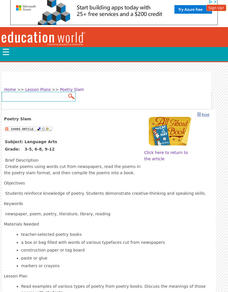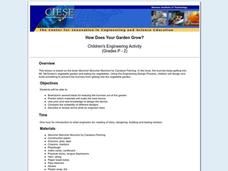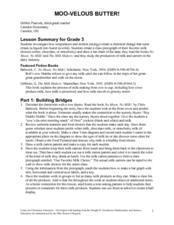Curated OER
Mr. Peabody's Apples
Students read Mr. Peabody's Apples. In this reading instructional activity, students complete pre-and post-reading activities to improve comprehension skills. Students role play scenes from the story to analyze.
Curated OER
Give and Take
Second graders explore the concepts of goods, services and community. They go on a community walk, find businesses and logos within their community, read books about communities, and compare various goods and services. They pick a job...
Curated OER
Butterfly Life Cycle
Students identify the stages in the butterfly life cycle. After completing a KWL chart, students participate in a brief lecture on the stages of the butterfly life cycle. Using reading books and Internet research, students complete an...
Curated OER
Complete the Sentences 3: Intermediate Level
In this complete the sentence worksheet, learners read 10 sentences and select the appropriate sight words to complete each of the sentences.
Curated OER
We All Need Trees
Students complete a guessing game. In this tree products instructional activity, students view various household items and try to determine if they were made from trees. They discuss their findings and then read books about trees.
Curated OER
Science vs. Science Fiction
Students acknowledge the difference between science and science fiction through a compare/contrast activity. They discuss their reading materials together. Students identify characteristics specific to science fiction.
Curated OER
Where Do You Live?
Second graders study and compare rural, suburban, and urban communities. They play a board game, read books about communities, and complete several other activities regarding the different types of communities. Several extension and...
Curated OER
The Human Body
Students research information about the human body. They read books and explore the Internet to gather information about the human body. Students create graphic representations and models of the body systems. Working in groups, they...
Curated OER
How Can Our Talents Be Used Together?
Students investigate their individual talents. In this togetherness activity, students listen to the poem "Togetherness Chant" and change the final stanza from play to work. Students brainstorm how they can use their individual talents...
Curated OER
Gingerbread Baby Student Books #3
Students are read the story "Gingerbread Baby". They create a mold of a gingerbread out of paper. They decorate one side of the paper and write their own story on the back.
Curated OER
Poetry Slam!
Create poems without writing! Young poets create poems using words cut from newspapers, read their poems aloud, and compile them in a book. This lesson allows the teacher to view each learner's creative process and assess their current...
Curated OER
Colors, Colors Everywhere
Students mix red, yellow, and blue frosting together to produce secondary colors. Pupils are shown that all colors are made from mixing primary colors of paint together. They discuss the color wheel and spread the "paint" icing on...
Curated OER
Careers - Community Helpers
Different types of community helpers are the focus of this sociology lesson. Learners read the book Community Helpers from A to Z, choose a community helper to focus on, complete a graphic organizer, draw a picture of their helper, and...
Curated OER
Writing Pourquoi Tales
Complete research on Pourquoi tales and then lead your students in creating their own. This lesson accompanies another on Pourquoi Tales on our site and deals more with the writing process. Your class will put the tales together in a...
Curated OER
Summer of the Monkeys
While reading the book Summer of the Monkeys by Wilson Rawls, the class ties together the core reading objectives, which are making predictions, comprehending new information, reading for author's purpose, independence in reading, and...
Curated OER
Build Mastery: Sequencing
Writing a summary is much easier once you've laid out the sequence of events. Show readers how these two skills are intertwined using this graphic organizer. Review the meaning of sequencing first, presenting the chart and possibly...
Curated OER
Jumanji
Third graders read the book, Jumangi. Then they divide into groups of four or five and choose a habitat - desert, wetlands, Arctic/Antarctic, etc. Then each group can research the habitat to learn what kind of animals live there.
Curated OER
"Ing" Words as Descriptors
This clever instructional activity has your students listen to story about bugs, work together to brainstorm list of "ing" words that describe bugs, create t-chart of words, choose words to place in poem template to create class poem...
Growing Minds
Growing Minds: Cabbage Exploration
It's all about cabbage in this scientific observation resource! After reading a related story, learners explore three varieties of cabbage. They observe the leaves using a leaf diagram, predicting what the middle might look like. They...
Steven's Institute of Technology
How Does Your Garden Grow?
What to do, bunnies are getting into the garden and eating all the carrots! After reading the story Muncha! Muncha! Muncha! the class works together to design a device that will keep those bunnies out of the garden. They get together in...
Curated OER
Moo-Velous Butter!
Third graders investigate how temperature and motion (energy) create a chemical change that turns cream ( a liquid) into butter (a solid). They create a class pictograph of their favorite mils choices (white, chocolate, or strawberry)...
Curated OER
Writing Process- Expository Writing
Expository writing is the focus of the language arts lesson presented here. In it, young writers review what expository writing is through a class discussion and teacher demonstration. Then, learners write expository text that describes...
Smithsonian Institution
Our Story: Duke Ellington and Jazz
Get parents or guardians into the swing of things with a jazzy homework assignment. A detailed six-page guide provides before, during, and after reading suggestions for Duke Ellington: The Piano Prince and His Orchestra, Andrea Davis...
Curated OER
Information Problem Solving
Middle schoolers locate the specific elements of text and illustrations that communicate setting, characterization, and plot in order to evaluate how the text and illustrations work together to communicate effectively.

























